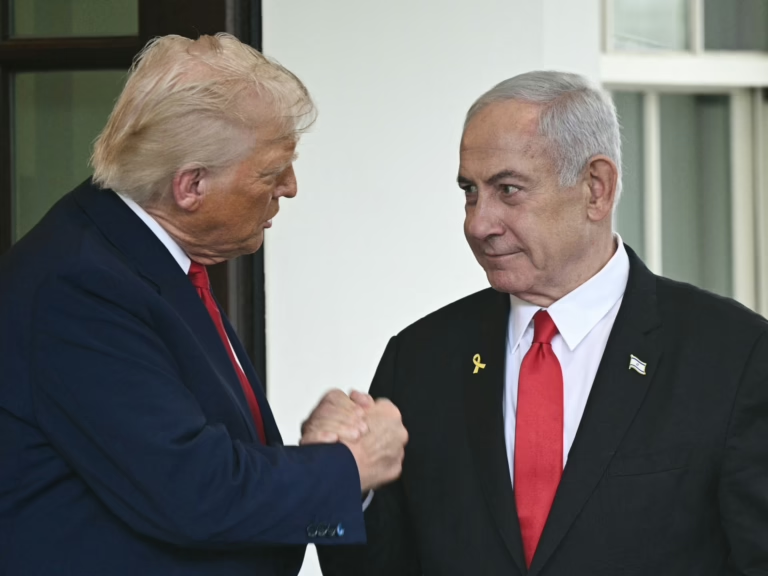Later this Monday, U.S. President Donald Trump and Israeli Prime Minister Benjamin Netanyahu will convene at the White House for their fourth meeting this year. This gathering comes amid discussions of a comprehensive plan to govern Gaza following nearly two years of devastating conflict initiated by Israel, a situation that could challenge the steadfast alliance between the two nations.
On Sunday, Trump took to his Truth Social platform, declaring in capital letters his vision for “greatness in the Middle East” and hinting at “something special” on the horizon. He has repeatedly emphasized the urgency of bringing the ongoing war to a close.
Netanyahu, speaking to Fox News, affirmed that Israel is collaborating closely with Washington to “make [the plan] a reality.”
This 21-point “post-conflict” strategy was initially unveiled to Arab and Muslim leaders during side meetings at the United Nations General Assembly in New York last week.
According to multiple Israeli and Western sources, the plan demands that Hamas release all 48 remaining hostages held in Gaza-approximately 20 of whom are believed to be alive-within a two-day window.
The proposal reportedly offers Hamas fighters the option to either exit Gaza or receive amnesty if they renounce armed resistance. It also envisions the entry of substantial humanitarian aid into the famine-stricken territory, the release of certain Palestinian detainees from Israeli prisons, and a phased withdrawal of Israeli military forces.
Hamas, however, stated on Sunday that it has not received any new proposals from mediators Egypt and Qatar, despite reports that these countries have been briefed on Trump’s plan.
While open to considering a fresh offer to end hostilities, Hamas’s armed wing cautioned that communication has been lost with teams holding two Israeli captives in Gaza City amid an intensifying Israeli ground offensive and relentless aerial bombardment, which continues to claim numerous Palestinian civilian lives daily and devastate the region.
Netanyahu’s Delicate Political Tightrope
Prime Minister Netanyahu appears to be cautiously endorsing the plan, despite it contradicting some fundamental stances of Israel’s far-right government.
Most notably, the blueprint leaves open the possibility of a future Palestinian state-an outcome vehemently opposed by many senior Israeli officials.
The plan explicitly rejects the forced displacement of Palestinians from Gaza and guarantees their right to return if they choose to leave, even after two years of brutal conflict that has left much of the enclave in ruins.
This stance contrasts sharply with the demands of Netanyahu’s hardline ministers and coalition allies, such as Finance Minister Bezalel Smotrich and Itamar Ben-Gvir, who have aggressively advocated for the complete destruction of Gaza’s remaining infrastructure and “encouraging voluntary migration” without the possibility of return.
These figures have pushed for cutting off all essential supplies-food, water, and medicine-as Israel did for months following the collapse of a ceasefire on March 18, triggering widespread famine and starvation. They also support rebuilding unauthorized Israeli settlements within Gaza after seizing control of the territory and annexing parts of the occupied West Bank.
Despite their previous praise of Trump as Israel’s strongest ally in the White House, these far-right leaders have criticized his plan, arguing that Netanyahu lacks the authority to accept any agreement that does not include the complete eradication of Hamas, which was a declared objective of the October 2023 conflict.
Netanyahu, however, may find himself under pressure from Trump, whose unwavering support and diplomatic backing Israel values highly.
In the Israeli parliament, Netanyahu’s Likud party holds 32 seats, leading a fragile minority government with just 60 out of 120 seats.
The prime minister’s position has been further weakened by the departure of two major ultra-Orthodox parties from the coalition in mid-July, triggered by disagreements over military conscription exemptions for religious students during the ongoing war.
The parties led by Smotrich and Ben-Gvir control 13 seats collectively, giving them the potential to destabilize Netanyahu’s government and force early elections if they withdraw their support.
Ben-Gvir resigned from his cabinet role in January to protest a ceasefire with Hamas that resulted in the release of some hostages but returned after Israel resumed its bombardment of Gaza.
Despite their hardline stance, these figures are unlikely to topple the government imminently, as Israel continues to restrict most aid to Gaza while intensifying its military operations within Gaza City, employing tanks and air and sea strikes.
Meanwhile, frequent Israeli raids and settler violence persist in the West Bank, with ongoing land seizures and home demolitions, even as Trump asserts he will prevent annexation of the territory.
At present, Trump’s proposal appears tentative and would require considerable time to implement, even if it gains unanimous approval and a United Nations mandate.
Envisioning Gaza’s Governance Post-Conflict
The framework proposed by Trump has been developed in partnership with Israel and an institute led by former UK Prime Minister Tony Blair, who was in office during the 2003 US-led invasion of Iraq based on disputed intelligence about weapons of mass destruction.
The plan contemplates appointing Blair to head a newly formed body called the Gaza International Transitional Authority (GITA), which would oversee Gaza’s administration following Hamas’s removal, potentially for several years.
On Monday, Israel’s Haaretz newspaper published a document outlining the governance structure of GITA, revealing a hierarchy that places senior international diplomats and business leaders at the helm, with Palestinians managing local affairs at the operational level.
The international board of GITA, likely to be headquartered in Egypt or another nearby location outside Gaza due to ongoing instability, may include a United Nations official, prominent Egyptian entrepreneurs, and Muslim representatives to enhance legitimacy.
An executive secretariat would operate beneath the board, supported by five commissioners responsible for humanitarian aid, reconstruction, legislative matters, security oversight, and coordination with the Palestinian Authority (PA), which is encouraged to reform in preparation for eventual governance responsibilities at an unspecified future date.
Beneath this structure, a Palestinian technocratic body appointed by the board would manage on-the-ground implementation, while a multinational stabilization force would control border crossings, Gaza’s coastline, and “perimeter zones” adjacent to Israel and Egypt-areas currently under Israeli occupation.
Despite this arrangement, Netanyahu and other Israeli officials have insisted that Israel will retain “security control” over the enclave.
The initial budget for GITA’s administration is projected at $90 million for the first year, increasing to $133.5 million and $164 million in the subsequent two years, excluding major expenditures such as reconstruction and humanitarian assistance.



















